
The past legal issues between VIA and Intel are well documented. For those who don't know, in a nutshell, VIA had been making Pentium 4 based chipsets without Intel's backing. Despite having reference boards, and chipsets available, alot of motherboard manufacturers were a little hesitant in building boards due to the legal issues. Recently, the proper partnership was formed, and now VIA is fully licensed to build Intel based chipsets.
Though VIA's initial offerings were decent enough, in the age of the i865 and i875, something more is needed. VIA's answer is the PT880, which was recently unveiled, and after a meeting with a VIA rep, we got a chance to try out their latest creation.
| Feature |
PT880 |
| North Bridge |
|
| Processor Support |
Intel® Pentium® 4 |
| Hyper Threading Support |
Yes |
| Front Side Bus |
800/533/400MHz |
| Memory Support |
Dual Channel
DDR400/333/266 w/ECC |
| Max Memory |
8.0GB |
| AGP Support |
AGP 8X/4X |
| Bus Architecture |
Asynchronous |
| South Bridge |
VT8237 |
| North/South Bridge Link |
Ultra V-Link (1066MB/sec) |
| Integrated Audio |
VIA Vinyl" Audio integrated 5.1 surround sound
VIA Vinyl" Gold 8-channel Audion (PCI)
|
| Network |
VIA Velocity Gigabit Ethernet companion controller
VIA integrated 10/100 Fast Ethernet
|
| Integrated Modem |
MC'97 |
| PCI Devices/Slots |
6 slots
Dual PCI-X bus support through VIA VPX2 I/O expansion bridge
|
| SATA |
Dual Channel Serial ATA supports 2 SATA devices
SATALite" interface for two additional SATA devices (4 total)
|
| V-RAID |
RAID 0, RAID 1, and RAID 0+1 & JBOD (SATA) |
| PATA |
Dual Channel Parallel ATA133 (up to 4 devices) |
| USB |
8 ports |
| Super I/O |
LPC Super I/O |
| IO APIC |
Yes |
| Power Management |
ACPI/APM/PCI/PM |
A quick glance at the specifications reveal that the PT880 supports almost every modern feature under the sun. This block diagram gives you a visual representation.

The PT880 supports the latest Pentium 4 processors, and their DualStream64 provides Dual Channel support. Hyper-Threading, and AGP 8X support are also present, covering items Pentium 4 owners will be looking for. The VIA DriveStation Controller Suite is the marketing description of the VIA VT8237 South Bridge, which handles the various storage interface technologies enthusiasts have come to expect from a modern motherboard.

Pictured above is the reference engineering sample our VIA rep left with us. The board we have is a late revision, and has already been shipped to manufacturers. Although the board is "ready", there's likely a new revision on the way, which may explain why we still don't see any retail boards based on the PT880.
At the moment, Intel is still pushing their Socket 478 architecture, so everything up to the Pentium 4 Extreme Edition should be supported. The reference sample uses passive cooling for the North Bridge, but it'll be up to motherboard makers to decide if passive or active will be the way to go for their boards.
Like the Dual Channel motherboards we're used to seeing using Intel's recent chipsets, the DualStream64 PT880s require ram to be installed in pairs for maximum performance. Memory support is still a bit sketchy at this time, but they have qualified Corsair's XMS series as fully compatible, and I didn't experience any issues using Mushkin (pictured above), Corsair or Kingston. A feature the DualStream64 has, which wasn't found on the K8T800 AMD platform, is the ability to run the ram asynchronous. The ability to run async wil maximize your options when trying to tweak system performance.
The third image to the right is a shot of the PATA and SATA connections. Again, it'll be up to manufacturers to decide how many interfaces to put, but it's safe to assume we'll likely see one PATA, and two SATA supported via the VT8237, and probably additional connections by a third party controller.
The VIA VT8237 South Bridge is something we're already familiar with, but in summary, the South Bridge handles the storage and connectivity options on the board. RAID-0, RAID-1, RAID-0+1, and JBOD configurations are all supported, giving you more storage options than are typically available. 5.2 and 7.1 sound is supported, as well as VIA Gigabit Ethernet, 10/100 Ethernet and up to eight USB 2.0 ports.
The VIA Modular Architecture Platform (V-MAP) is VIA's unique architecture that allows for faster product development and speeds up time to put to market. Basically, items like controllers are developed, and are part of a unit (though they can work independently). Manufacturers can purchase "packages" that VIA puts together, that will save time and cost. The Ultra V-Link interconnect is part of the V-MAP architecture, and links the North and South Bridge with a 1066MB/s connection.
The VT1211 is a full function Super I/O chip, and it is responsible for hardware monitoring, floppy controller, and handling legacy connections such as the serial ports.
The VIA Envy24PT is a multi-channel audio controller with 24-bit resolution and 96KHz sampling rates. This is pretty high-end, and should motherboard manufacturers include it, it'll be one of the most impressive sound solutions integrated into a motherboard.
The VIA Velocity VT6120 Gigabit Ethernet Controller is another impressive piece of hardware, supporting 10/100/1000 speeds at full and half-duplex. Developed jointly with , the controller has an adaptive interrupt scheme which will reduce the CPU load during data transfer. There will also be VIA's GigaCheck link-management software packaged with boards that use the controller to help diagnose any problems and to run reports.
The VIA VT6420 Controller is another RAID controller present on our reference board, and supports RAID-0, RAID-1, RAID-0+1, and JBOD configurations.

When motherboard manufacturers start producing their PT880 motherboards, your IO options will certainly differ from our configuration. In fact, our board isn't fully ATX compliant and the back IO is too long to fit in our case. Other than the legacy connections, you can see we have four USB, and two NICs, as well as six channel sound.
The BIOS

The reference board makes use of the Pheonix Award BIOS, but expect motherboard manufacturers to implement their own (or the same) choices.
The Advanced Chipset features allow a great deal of customization and tweaking. In the DRAM Clock/Drive Control, you're given quite a bit of control of what you can do. Depending on the speed of your ram, you can adjust the DRAM Clock from 100MHz to 200MHz.
For your timings, you can either use the factory pre-sets, Turbo or Ultra, or set it to manual to adjust them yourself. I don't have much documentation on the DRAM Bus selection, but for maximum performance, you'll want to set it Dual Channel. What took some time to figure out though was where the ram needed to be seated. After a bit of moving around, the reference board required the ram to be in slot #1 and #4. You can expect retail boards to properly document this.
Under Frequency/Voltage Control, this is where you can play with the overclocking. The FSB range is 167 to 255. This range is a little conservative, but again, manufacturers will likely make some changes here.
The voltage options were fairly low, with the CPU vCore maxing out at 1.775v. This is somewhat average, but like many BIOS features, you can expect this to change. For DDR, you are allowed up to a maximum of 2.75v, and for the AGP, 1.65v.
Overclocking
Overclocking was no easy task. For the heck of it, the first OC we tried was 250FSB. This is a slam dunk with most Springdale and Canterwood motherboards, and something I knew for certain that our ram could do. Unfortunently, we were greeted with a blank screen. A CMOS reset fixed the problem, but no matter what voltages we adjusted, nothing could get us 250FSB. 240FSB was a no go, and it wasn't until we got to 235FSB, we were even able to POST.
We had various levels of success with 220FSB to 230FSB, sometimes getting into Windows, sometimes not. I was able to begin some benchmarking at 222FSB, but as soon as SiSoft started up, we had a system crash serious enough to force a reinstall of Windows.
In the end, I had to settle for a paltry 208FSB. At this time, I'm uncertain what the potential is for the PT880, as motherboard manufacturers will no doubt try some of their own tricks, so for now, let's just say that there is a lot of work that needs to be done in this area.
Test Setup
PT880 Reference: Pentium 4 2.4C, 2 x 512MB Mushkin High Performance PC4000, AIW Radeon 9600 Pro, 120GB Maxtor SATA 150, Windows XP SP1, VIA Hyperion 4in1 drivers 4.49, ATI Catalyst 3.9
ASUS P4C800-E Deluxe: Pentium 4 2.4C, 2 x 512MB Mushkin High Performance PC4000, AIW Radeon 9600 Pro, 120GB Maxtor SATA 150, Windows XP SP1, ATI Catalyst 3.9
Test software will be:
Unreal Tournament 2003
Quake 3: Arena
Return to Castle Wolfenstein
Though most benchmarks should be self explanitory, VirtualDub and TMPGEnc may raise a few eyebrows. We've elected to use these apps as real-world tests, and wrote this small article to explain our testing methodology.
The comparison platform will be the ASUS P4C800-E Deluxe, in order to compare Intel's flagship DDR platform against VIA's. The Kingston modules will be run at 2.5-3-3-6.
SiSoft Sandra 2004
Although a synthetic benchmark, it's a popular one, freely available if you wish to make comparison benchmarks. We will be testing the CPU, MMX, and memory speeds, using the 32-bit 2004 version.
CPU Arithmetic Benchmark

CPU Multimedia Benchmark
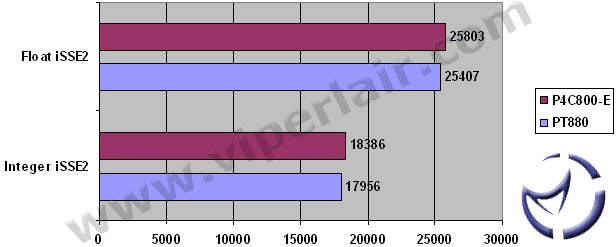
Memory Benchmark
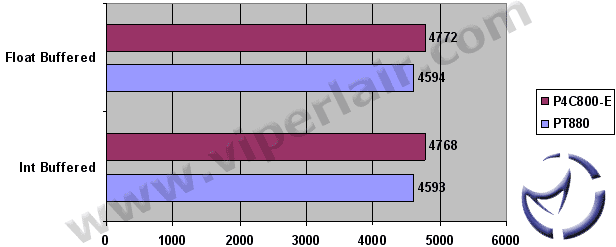
Though the Canterwood maintains a performance lead across all the synthetic benchmarks, the PT880 does very well for itself. Compared to several other Pentium 4 based boards we've looked at, performance is at Springdale levels.
PiFast
A good indicator of CPU/Motherboard performance is version 4.2, by Xavier Gourdon. We used a computation of 10000000 digits of Pi, Chudnovsky method, 1024 K FFT, and no disk memory. Note that lower scores are better, and times are in seconds.
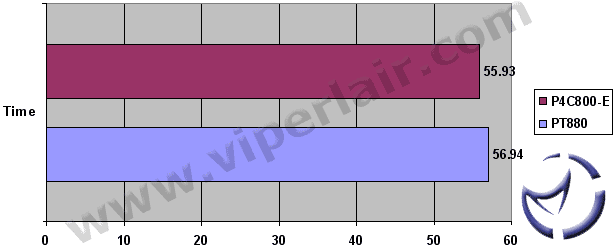
Lower is better
Very close results, with the PT880 trailing the Canterwood by about one second. Just a reminder that we're looking at an engineering sample, and it's likely we'll see some better numbers when the boards are released in the retail market.
VirtualDub Audio Extraction
We ripped the audio of at 44 100Hz, no compression using VirtualDub 1.5.8 (Build 18068). Times are in seconds, and lower is better.

Lower times are better
The PT880 takes our sound extraction tests by one second. Score one here for VIA.
TMPGEnc 2.521
We used the same Animatrix file and the WAV created from VirtualDub, and converted it into a VCD compliant MPEG-1 file. Times are in minutes:seconds, and lower is better.
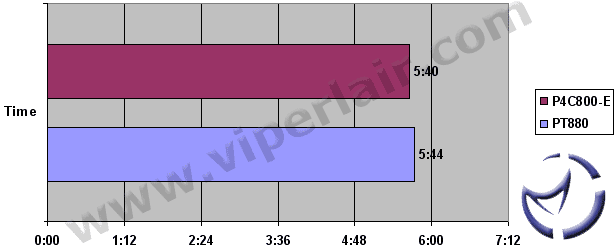
Lower times are better
Another close one here, but the Canterwood takes the MPEG encoding test by four seconds.
Quake 3: Arena @ 640

Return to Castle Wolfenstein @ 640
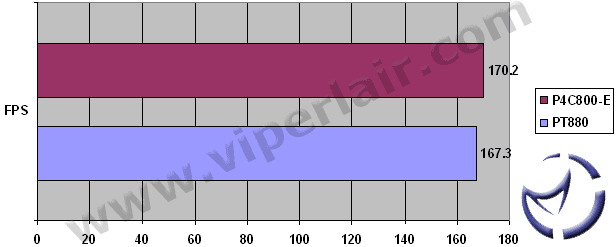
In gaming, the PT880 seems well suited for whatever may be thrown at it. Performance is very close to the Canterwood, and it probably won't take too much for VIA to squeeze more out of the PT880.
Subsystem Testing - Sound Tests
In terms of sound quality, I found gaming to be very acceptable, as was the case with movie and MP3 playback. Music playback was very impressive, and with good quality speakers, the Envy controller sounds very good.
USB 2.0 Performance
We did the same file transfer tests as in the Mushkin Flashkin review, copying several small files from the hard drive to the flash drive.
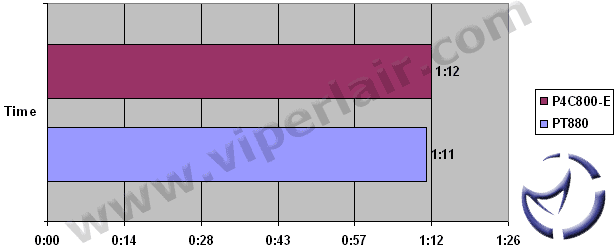
One second is all that separates the two boards, but the PT880 takes this one.
SATA Performance
Testing was done using a freshly imaged disk, split into partitions of 40GB, 50GB, 30GB (roughly), and benched on a Seagate 120GB SATA drive using the VIA controller.
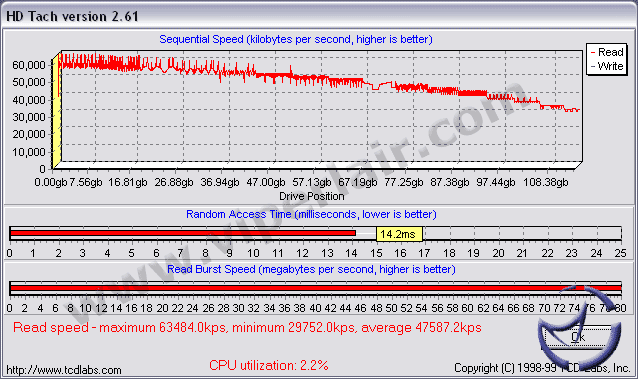
CPU utilization was quite low, averaging 2.2%. The average read speed was about 47500kps, peaking as high as 63484kps. These results were quite good, and some of the lowest CPU utilization scores we've seen.
Network Performance
We used to test the networking speed, and Windows Task Manager for CPU usage. We copied our RtCW directory, which has a wide variety of files contained within it, and totals 700MB, from our Gigabit capable K8T Neo-FIS2R machine, to the VIA PT880 box. We also zipped the folder, reducing it to about 640MB for our large file tests.
Both systems were connected via a CAT-5E crossover cable, which should prevent any bottlenecks that would arise with our standard 10/100 router. We'll be testing both VIA's 10/100 NIC, as well as the Gigabit NIC.
Small Files Test - 700MB Total

|

|
|

|

|
|
Download 10/100
|
Upload 10/100
|
|
Download 1000
|
Upload 1000
|
On the 10/100 NIC, the Upload speeds averaged 10.19mB/sec, which is a little faster than the 9.06mB/sec download transfer rate. CPU usage was also lower, peaking at 24%, whereas the download peaked at 26%.
The Gigabit NIC ripped through these tests, averaging 23.64mB/sec on the download, and 31.79mB/sec on the upload. CPU usage was a lot higher than the 10/100 NIC though, averaging between 44% to 48% downloading and uploading.
Large File Test - 640MB Total

|

|
|

|

|
|
Download 10/100
|
Upload 10/100
|
|
Download 1000
|
Upload 1000
|
Large file tests mirrored the small files tests, but the transfer rates during download and upload were a bit faster. CPU usage was actually lower though, by about 1%-2% on average.
Final Words
The board was very stable during testing, though overclocking didn't go very well at all. Considering that this was a reference board, the PT880 appears to be very close to being ready for the market.
Performance was very impressive, and more so when you consider VIA's history with pricing. If they can get these boards to market at a competitive price, Springdale boards are going to have a real fight on their hands. The Canterwoods still hold strong in the performance arena, but with a bit more tweaking in either their controllers, or their drivers, VIA may be able to push the PT880 enough that there won't be much difference in this area.
I didn't get the chance to spend more time evaluating some of the VIA specific technologies, but based on what we've seen today, things are looking very good indeed. There's still some work to be done, and we'll be quite interested in seeing what motherboard manufacturers can churn out.
If you have any comments, be sure to hit us up in our forums.
HOME



